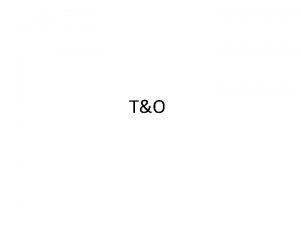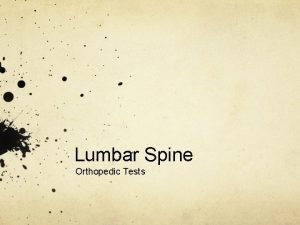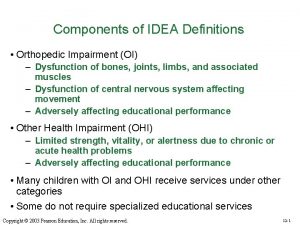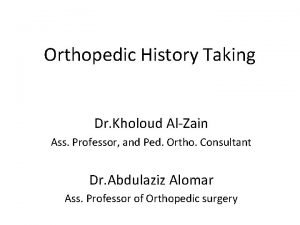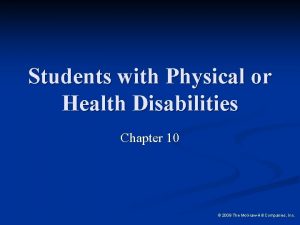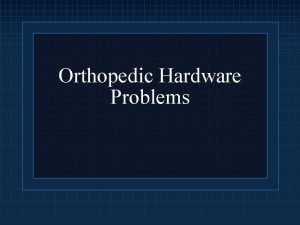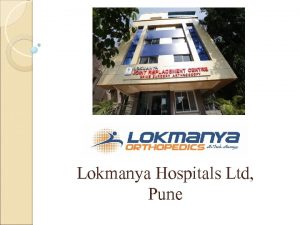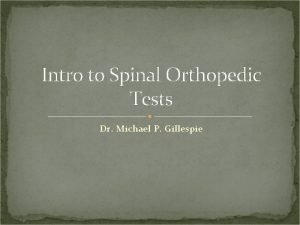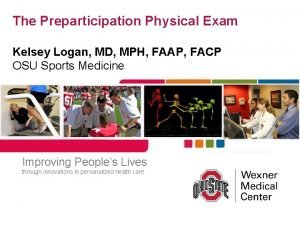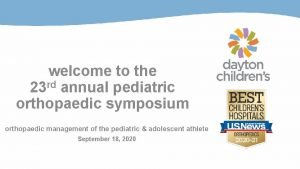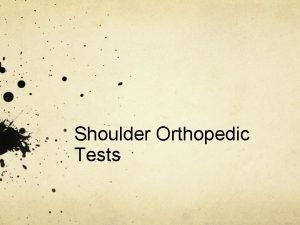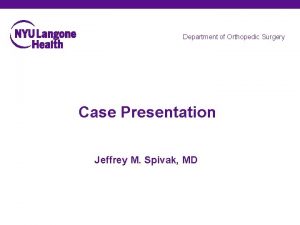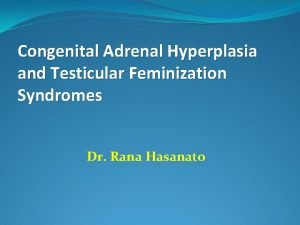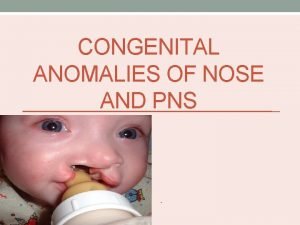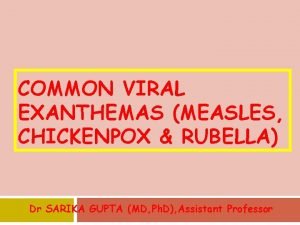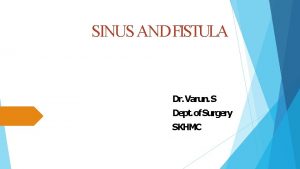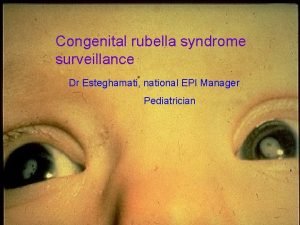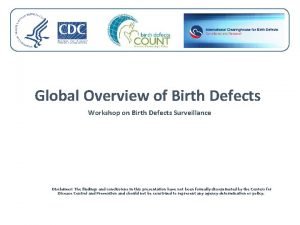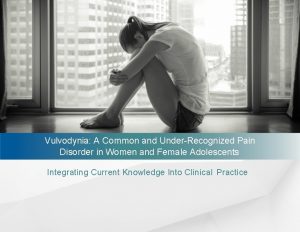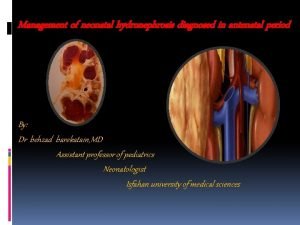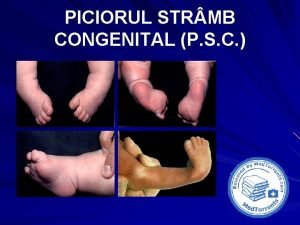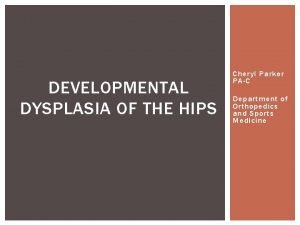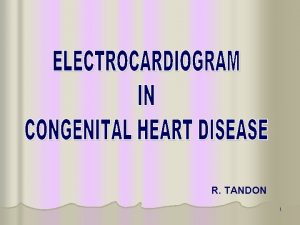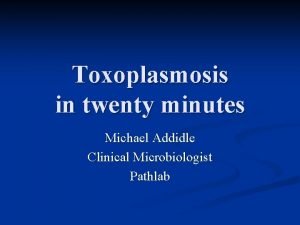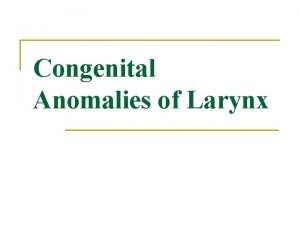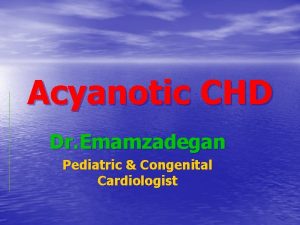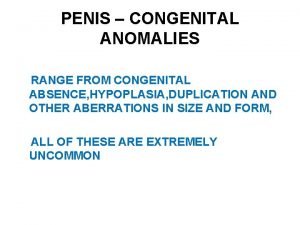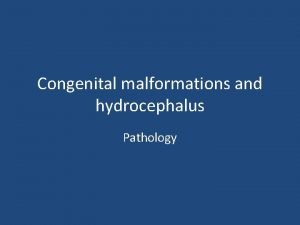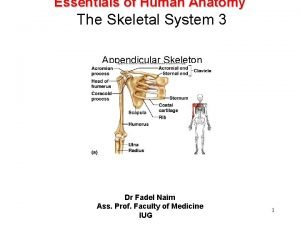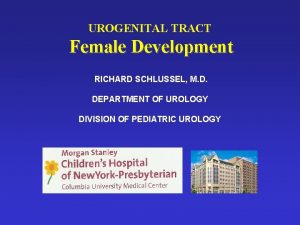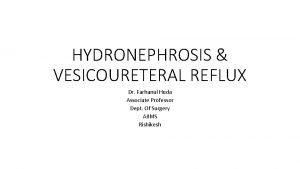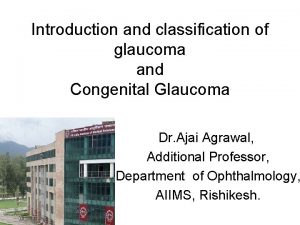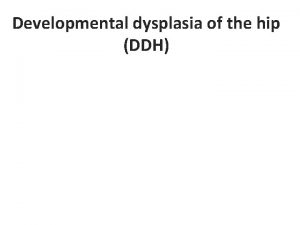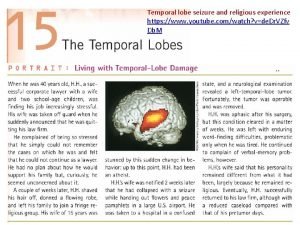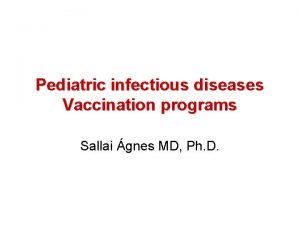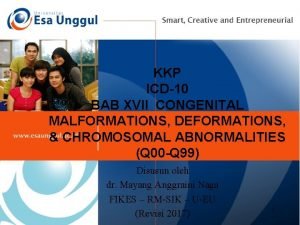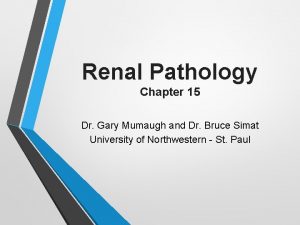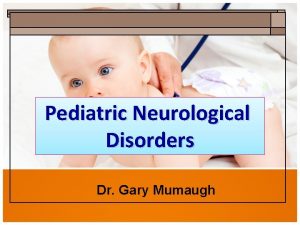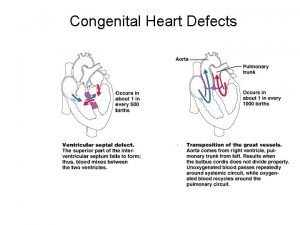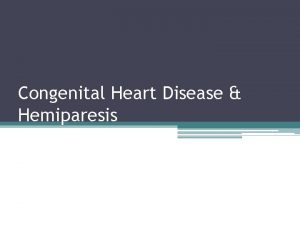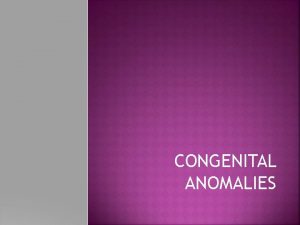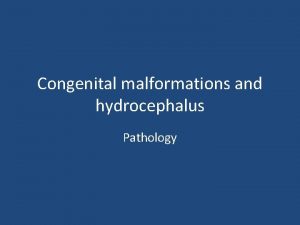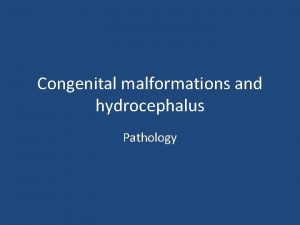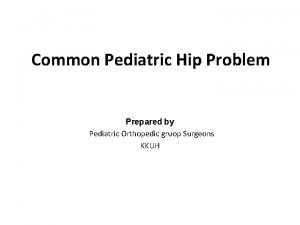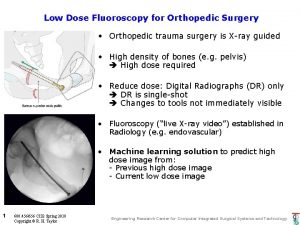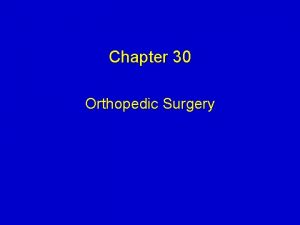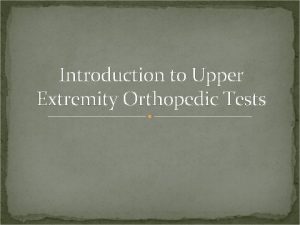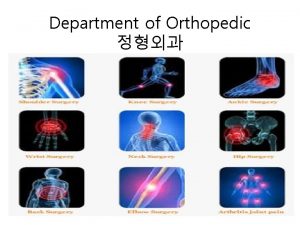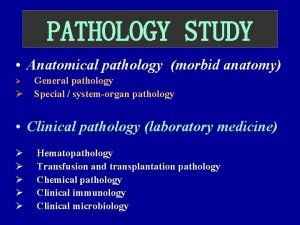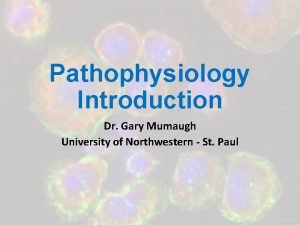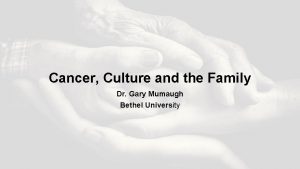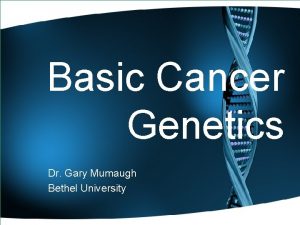Pediatric Orthopedic Pathology Dr Gary Mumaugh 1 Congenital












































- Slides: 44

Pediatric Orthopedic Pathology Dr. Gary Mumaugh 1

Congenital Defects Clubfoot (congenital equinovarus) Forefoot is adducted and supinated Positional equinovarus Idiopathic congenital equinovarus Teratologic equinovarus 2

Clubfoot 3

Clubfoot 4

Congenital Defects Developmental dysplasia of the hip (DDH) Abnormality of the hip that can affect the femoral head, acetabulum, or both Risk factors: Female sex Positive family history Breech presentation 5

Congenital Defects Developmental dysplasia of the hip The hip can present as subluxated, dislocated, or acetabular dysplasia Manifestations: Asymmetry of skinfolds at groin crease Galeazzi sign Limitation of hip abduction Positive Ortolani sign Positive Barlow test 6

Congenital Defects Developmental dysplasia of the hip Clinical management Outcome becomes poorer with age Pavlik harness Closed reduction with spica casting Surgery 7

8

9

Osteogenesis Imperfecta “Brittle bone disease” Defect in type I collagen production Bone and vessel collagen 10

Osteogenesis Imperfecta Clinical manifestations: Osteopenia Increased rate of fractures Bone deformity (bowing) Short stature Blue sclera and poor dentition Aortic aneurysm 11

Osteogenesis Imperfecta Clinical management: Surgical Intramedullary and telescoping rod placement Medical Increased calcium and vitamin D Biphosphates 12

Osteogenesis Imperfecta 13

14

Osteomyelitis Bone infection from bacteria or tuberculosis (granulomatous) Acute hematogenous osteomyelitis in children frequently begins as a blood abscess in the metaphysis of the bone The abscess ruptures under the periosteum and spreads along the bone shaft or into the bone marrow 15

Osteomyelitis Clinical manifestations: Pain, swelling, warmth, fever Elevated white blood cells, C-reactive protein, and erythrocyte sedimentation rate Clinical management: Antibiotics for 6 -week regimen Surgical debridement 16

17

18

19

Septic Arthritis Caused by bacteria or granulomatous Surgical emergency Occurs primarily or secondary to osteomyelitis Lysosomes destroy articular cartilage and interrupt blood supply 20

Septic Arthritis Clinical manifestations: Pseudoparalysis Inability to bear weight Guarded motion of the joint Malaise Anorexia 21

Septic Arthritis Clinical management: Staphylococcus aureus most common bacteria Surgical debridement Antibiotic therapy Long-term follow-up 22

Septic Arthritis 23

24

Juvenile Rheumatoid Arthritis (JRA) Childhood form of rheumatoid arthritis The basic pathophysiology of JRA is the same as the adult form Three distinct modes of onset: Oligoarthritis Polyarthritis Stills disease 25

Juvenile Rheumatoid Arthritis Differences in JRA and adult RA: Large joints are affected Chronic uveitis Low detection of rheumatoid factor Subluxation and ankylosis of the cervical spine Treatment Supportive with anti-inflammatories and methotrexate 26

Osteochondrosis Avascular diseases of the bone Decrease blood supply Trauma Change in clotting sensitivity Vascular injury Legg-Calvé-Perthes disease Interrupted blood supply to the femoral head Deformation due to ischemia is permanent 27

Osteochondrosis 28

Osteochondrosis Legg-Calvé-Perthes disease Clinical manifestations: Spasm on rotation of hip Limited internal rotation or abduction of hip Trendelenburg gait Clinical management: Anti-inflammatories Serial radiographs Surgery 29

Legg-Calvé-Perthes Disease 30

Osteochondrosis Osgood-Schlatter disease Tendinitis of the anterior patellar tendon and osteochondrosis of the tubercle of the tibia One of the most common ailments in children involved in sports Clinical manifestations: Pain Swelling Clinical management: Restricted activity Bracing and knee immobilizer 31

Scoliosis is a curvature of the spine that involves both lateral curvature and rotation Idiopathic (80% of cases) Congenital Teratogen Medical management: Bracing Surgery 32

Scoliosis 33

Muscular Dystrophies Group of inherited disorders that cause degeneration of skeletal muscle fibers The muscular dystrophies cause progressive, symmetric weakness and wasting of skeletal muscle groups 34

Duchenne Muscular Dystrophy Most common of the muscular dystrophies X-linked recessive inheritance Deletion of a segment of DNA or a single gene defect on the short arm of the Xchromosome Generally affects boys Duchenne muscular dystrophy gene Encodes for the dystrophin protein Dystrophin maintains the structural integrity of the cytoskeleton 35

Duchenne Muscular Dystrophy Manifestations of the disorder begin to appear by approximately 3 years of age: Slow motor development Progressive weakness Muscle wasting Sitting and standing are delayed The child is clumsy, falls frequently, and has difficulty climbing stairs 36

Musculoskeletal Tumors Benign bone tumors Osteochondroma Inherited syndrome of hereditary multiple exostoses Nonossifying fibroma Sharply demarcated, cortically based lesions of fibrocytes 37

Musculoskeletal Tumors Malignant bone tumors Osteosarcoma Most common tumor in childhood Originates in mesenchymal cells Linked to deletion of genetic material Bulky tumor extending into soft tissue 38

Musculoskeletal Tumors Osteosarcoma Clinical manifestations: Night pain, swelling, warmth, Cough, dyspnea, and chest pain if lung metastasis Clinical management: Graded according to malignancy Surgery and chemotherapy 39

Musculoskeletal Tumors Ewing sarcoma Most lethal bone tumor Translocation of chromosome 11 and 22 Breaks through bone to form soft tissue mass Metastasizes to nearly every organ 40

Musculoskeletal Tumors Ewing sarcoma (cont’d) Clinical manifestations: Pain that increases in severity Fever Malaise Anorexia Clinical management: Radiation and chemotherapy Surgical debridement 41

Malignant Bone Tumors 42

Malignant Bone Tumors 43

Nonaccidental Trauma “Corner” metaphyseal fractures Long bone fractures caused by a twisting force Transverse tibial fractures are the most common Associated with child abuse, but osteogenesis imperfecta must be ruled out Legally mandated to report child abuse 44
 Spica cast
Spica cast Orthopedic icats
Orthopedic icats Bechterew test
Bechterew test Idea orthopedic impairment
Idea orthopedic impairment Orthopedic history
Orthopedic history Causes of orthopedic impairment
Causes of orthopedic impairment Uva template powerpoint
Uva template powerpoint Todd wilcox md
Todd wilcox md Lokmanya orthopedic hospital pune
Lokmanya orthopedic hospital pune O'donoghue's orthopedic test
O'donoghue's orthopedic test Orthopedic case presentation
Orthopedic case presentation 2 minute orthopedic exam
2 minute orthopedic exam Dr claire beimesch
Dr claire beimesch Dugas orthopedic test
Dugas orthopedic test Orthopedic case presentation
Orthopedic case presentation Search engine optimization for orthopedic practices
Search engine optimization for orthopedic practices Congenital adrenal hyperplasia characteristics
Congenital adrenal hyperplasia characteristics Congenital anomaly
Congenital anomaly Congenital rubella syndrome triad
Congenital rubella syndrome triad Anal advancement flap
Anal advancement flap Congenital rubella syndrome
Congenital rubella syndrome Congenital
Congenital Birth defects causes
Birth defects causes Congenital anomaly
Congenital anomaly Vulvodynia
Vulvodynia Potter face oligohydramnios
Potter face oligohydramnios 5 cyanotic congenital heart disease
5 cyanotic congenital heart disease Codivila
Codivila Ortolani galeazzi barlow
Ortolani galeazzi barlow Congenital heart
Congenital heart Michael addidle
Michael addidle Arytenoid anomaly
Arytenoid anomaly Endocardial cushion defects
Endocardial cushion defects Penis
Penis Congenital malformations
Congenital malformations Greater and lesser pelvis
Greater and lesser pelvis Canadian congenital heart alliance
Canadian congenital heart alliance Vaginal agensis
Vaginal agensis Congenital hydronephrosis
Congenital hydronephrosis Pediatric knee chest position
Pediatric knee chest position Trabeculodysgenesis
Trabeculodysgenesis Ddh définition
Ddh définition Congenital amusia
Congenital amusia Congenital rubella
Congenital rubella Icd 10 labioschisis
Icd 10 labioschisis

